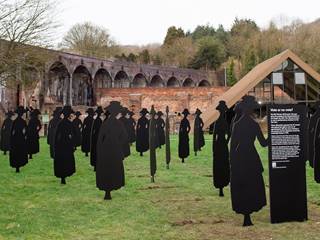1918 Votes for Women Installation
Vote or no vote?
6 February 2018 marked 100 years since the passing of the Representation of the People Act 1918, which allowed women to vote in parliamentary elections for the first time.
The Act was passed after hundreds of thousands of women joined the workforce to support the war effort during the First World War, and followed more than fifty years of campaigning by suffragists and suffragettes. It marked a decisive turning point in the fight for women’s rights, and affected every corner of Britain, including the Ironbridge Gorge and the women working in its industries. To celebrate this defining moment in British history, we have installed silhouettes of women on the green at Coalbrookdale to represent the thirty-seven women, out of approximately 160, who were working in the ceramic and iron industries across the Gorge and gained the right to vote in 1918.
Whilst 1918 was a turning point in the fight for women’s rights, the Act that was passed was limited in its impact. This excluded millions of ordinary working women from voting, including most women working in the Gorge’s industries. It also excluded the majority of women who had worked throughout the war, who had taken on men’s roles, had worked in dangerous munitions factories, and had kept the country running.
Ultimately, the installation on the Green at Coalbrookdale will serve as a reminder that 1918 was a landmark moment in British history and a turning point in the fight for women’s rights, but that it was not the end of the story. It was another ten years before women gained voting rights on equal terms with men, and the fight for social and political equality in Britain continues today, for the right to live free from discrimination, harassment and violence, and to earn a fair and equal wage.
Click below to find out more about the women, working in the industries of the Ironbridge Gorge, who could and couldn't vote in Ironbridge in 1918.
the women who could vote
There are 37 silhouettes on the Green at Coalbrookdale. They represent the 37 women who gained the right to vote out of approximately 160 who were working in the ceramic and iron industries across the Ironbridge Gorge in 1918.
Women could only vote if they were over the age of 30 and if they or their husband owned a certain amount of property.
THE WOMEN WHO couldn't VOTE
Across the UK, approximately 40% of women gained the right to vote, and these were mainly older, wealthier, married women.
This excluded millions of ordinary women from voting.

